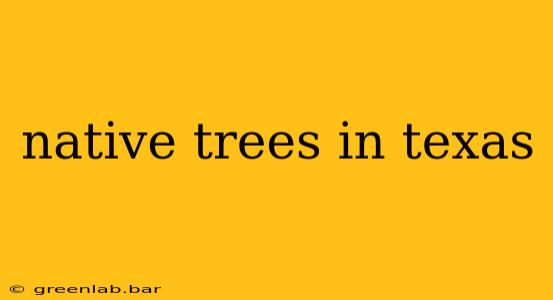Texas, with its diverse geography ranging from humid East Texas forests to the arid West Texas plains, boasts an incredible variety of native tree species. Understanding these trees is crucial for anyone interested in landscaping, conservation, or simply appreciating the natural beauty of the state. This guide explores some of the most prominent and ecologically important native trees found across Texas's diverse regions.
East Texas Trees: A Lush, Humid Landscape
East Texas, with its abundant rainfall and fertile soil, supports a rich tapestry of deciduous trees. These trees, known for their vibrant fall colors, are a hallmark of the region's beauty.
Common East Texas Native Trees:
- American Sycamore (Platanus occidentalis): Recognizable by its mottled bark, large leaves, and impressive size, the American Sycamore is a dominant species in bottomland hardwood forests. Its tolerance for flooding makes it a keystone species in riparian ecosystems.
- Red Oak (Quercus rubra): A majestic tree known for its reddish-brown bark and deeply lobed leaves. Red Oaks provide crucial habitat and food for wildlife, especially squirrels and birds.
- Sweetgum (Liquidambar styraciflua): Famous for its star-shaped leaves and fragrant, spiky seed balls. Sweetgums display spectacular fall foliage, transitioning through vibrant reds and oranges.
- Pecan (Carya illinoinensis): A prized nut-bearing tree, the Pecan is a crucial part of the East Texas landscape. Its nuts are a valuable food source for wildlife and humans alike.
Central Texas Trees: Adapting to Change
Central Texas experiences a more moderate climate than East Texas, with hotter summers and milder winters. The tree species here are adapted to withstand these fluctuations.
Common Central Texas Native Trees:
- Live Oak (Quercus virginiana): The iconic Live Oak, with its sprawling branches and evergreen foliage, is a symbol of Texas. Its longevity and resilience make it a treasured tree in landscapes and parks.
- Cedar Elm (Ulmus crassifolia): This drought-tolerant elm is a common sight across Central Texas, known for its small, serrated leaves and its ability to thrive in challenging conditions.
- Texas Red Oak (Quercus buckleyi): A smaller oak than its eastern counterpart, the Texas Red Oak is well-suited to the drier conditions of Central Texas.
West Texas Trees: Resilience in Aridity
West Texas, characterized by its arid climate and sparse rainfall, presents unique challenges for tree survival. The trees found here are remarkably drought-tolerant and adapted to harsh conditions.
Common West Texas Native Trees:
- Desert Willow (Chilopsis linearis): A flowering tree with trumpet-shaped blooms, the Desert Willow is a beautiful addition to xeriscapes and drought-tolerant landscapes.
- Mesquite (Prosopis spp.): Several species of Mesquite trees thrive in West Texas, known for their deep root systems that access groundwater. While often considered a nuisance, Mesquite plays a crucial role in the ecosystem.
- Texas Persimmon (Diospyros texana): This small tree produces edible persimmons, offering a valuable food source for wildlife and humans.
Choosing Native Trees for Your Landscape
Selecting native trees for your landscape offers numerous benefits: they are adapted to the local climate and soil, require less water and maintenance, support local wildlife, and contribute to the overall ecological health of the region. When choosing a tree, consider your specific location within Texas, the available sunlight, and soil conditions.
Conclusion
Texas's diverse climate and geography support a rich diversity of native trees, each contributing to the unique character of the state's different regions. Understanding these trees, their ecological roles, and their adaptability is crucial for appreciating and conserving the natural beauty of the Lone Star State. By choosing native trees for our landscapes, we can contribute to a healthier and more sustainable environment for future generations.

